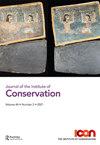保护无形的和不可估量的:探索博物馆背景下的健康框架
IF 1
0 HUMANITIES, MULTIDISCIPLINARY
引用次数: 1
摘要
近年来,幸福的概念蓬勃发展。虽然关于幸福的讨论在经济学中有着悠久的历史,但它现在是文化研究中一个受欢迎的关注领域。这一主题特别关注身心健康,但也关注文化认同、归属感以及与物质或非物质遗产的情感和精神联系。由于基于价值观的福利应用加强了以人为本的方法和社区赋权的论点,一些博物馆越来越多地将这一概念纳入其宗旨,并在其管理和收藏护理中设定目标。鉴于每个国家都致力于在国家层面制定福利政策框架,本文旨在分析在新西兰和苏格兰的四个文化机构中动员的福利的范围和意义。本文章由计算机程序翻译,如有差异,请以英文原文为准。
Preserving the intangible and immeasurable: exploring wellbeing frameworks in the museum context
Abstract The concept of wellbeing has blossomed in recent years. While discussion of wellbeing has a longer lineage in economics, it is now a popular area of concern in cultural studies. The subject has seen special focus on mental and physical health, but also cultural identity, sense of belonging, and in emotional and spiritual connections to tangible or intangible heritage. Because the values-based application of wellbeing strengthens the argument for people-centred approaches and community empowerment, some museums are increasingly integrating the concept to justify their purpose and set their objectives within their administration and collections care. This article aims to analyse the scope and meaning of wellbeing as mobilised in four cultural institutions located in New Zealand and Scotland given that each country has committed to having a wellbeing policy framework at the national level.
求助全文
通过发布文献求助,成功后即可免费获取论文全文。
去求助
来源期刊

Journal of the Institute of Conservation
HUMANITIES, MULTIDISCIPLINARY-
CiteScore
1.50
自引率
0.00%
发文量
22
期刊介绍:
The Journal of the Institute of Conservation is the peer reviewed publication of the Institute of Conservation (Icon). As such, its aims reflect those of Icon, to advance knowledge and education in conservation and achieve the long term preservation and conservation of moveable and immoveable cultural heritage. The Journal provides a collective identity for conservators; it promotes and supports both the profession and professionalism. With international contributions on all aspects of conservation, it is an invaluable resource for the heritage sector. The specific aims of the Journal are to: 1. promote research, knowledge and understanding of cultural heritage conservation through its history, practice and theory 2. provide an international forum to enable and disseminate advances in research, knowledge and understanding relating to conservation and heritage 3. champion and support professional standards of heritage conservation in the UK and internationally 4. provide a permanent record of issues relating to conservation and heritage 5. be financially and operationally sustainable. To achieve these aims, the Journal invites contributions from all those involved in the conservation of cultural heritage and related activities. Areas of interest include understanding cultural heritage materials and their degradation; subject reviews and histories of cultural heritage materials and conservation treatments; new, innovative or improved approaches to conservation and collections care theory, practice, communication, management and training; case studies demonstrating new, innovative or improved approaches; and conservation in its wider context. Submitters are encouraged to demonstrate how their work is of practical application to conservation. To maintain professional standards and promote academic rigour, submissions of articles and shorter notices are subject to an anonymous peer review process.
 求助内容:
求助内容: 应助结果提醒方式:
应助结果提醒方式:


